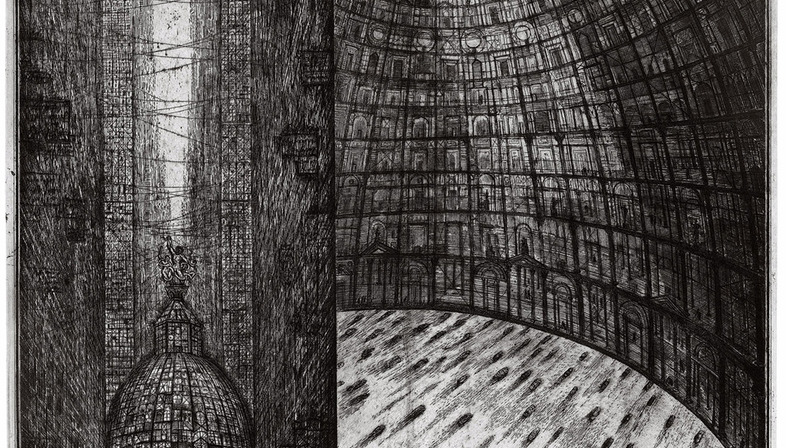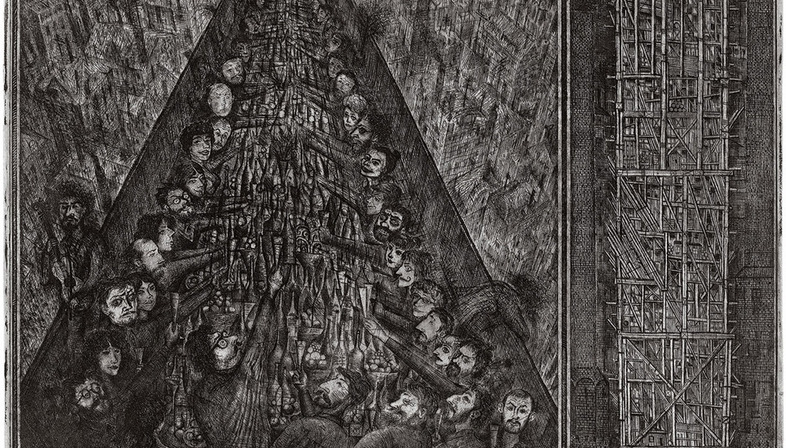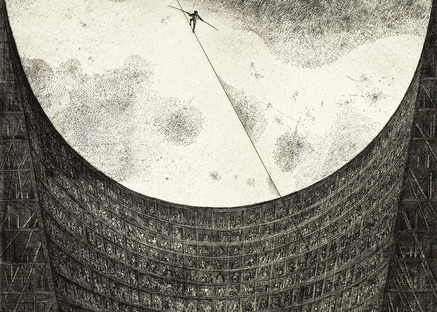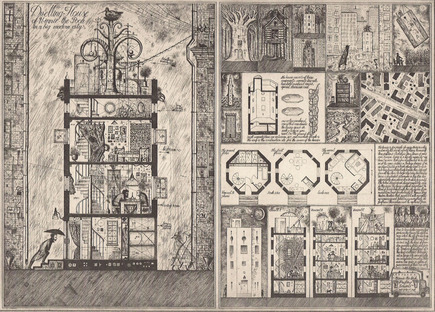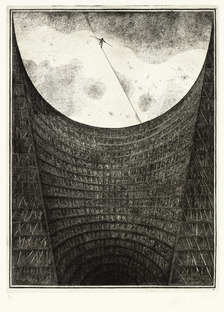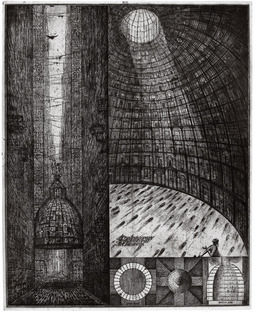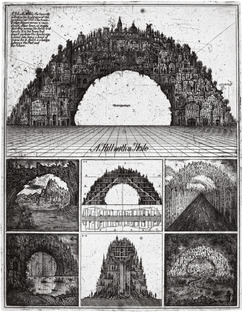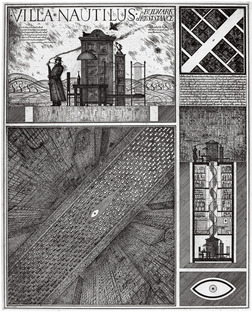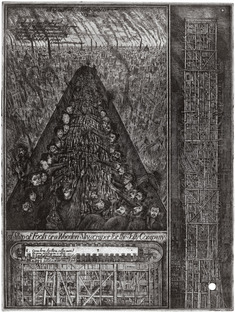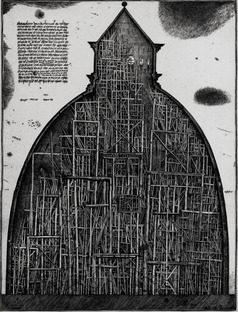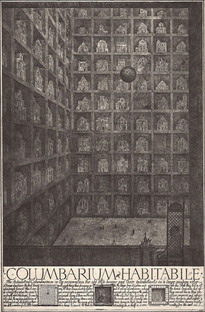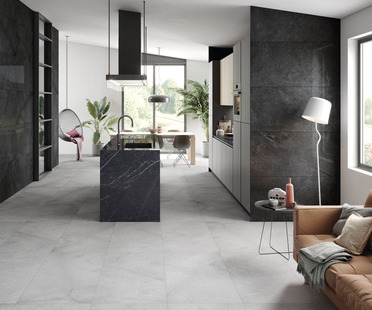20-07-2021
PAPER ARCHITECTS
Ilya Utkin, Alexander Brodsky ,
Paper Architecture,
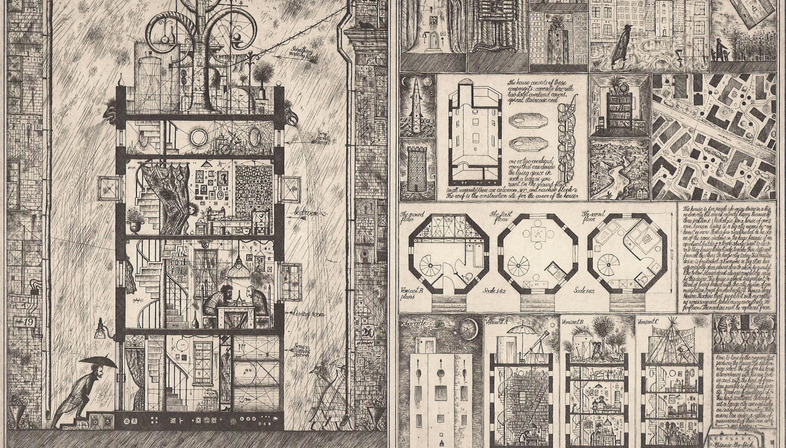
Paused...
A group of young visionary architects, just graduated from the Moscow Institute of Architecture, decided to found their own movement, contesting this situation, which did not admit any possibility to affirm one's own voice. These young people devoted a desperate search to avoid the humiliating limitations of a bureaucratic apparatus that so heavily stifled their ambitions as artists. To counter the formal uniformity envisaged by the communist aesthetics, which penalized anyone who deviated from it, forcing to respect standard methods for cheap and quick buildings construction, rejecting any specialized workmanship, with no concern about users or their needs, they conceived a revolt strategy difficult to be deciphered, made up of allusions legible only by an attentive and above all intellectually and culturally trained eye. As someone wrote in a beautiful book dedicated to a couple of them, their work on paper should be considered the answer to “a bleak professional scene in which only artless and ill-conceived buildings, diluted through numerous bureaucratic strata and constructed out of poor materials by unskilled laborers, were being erected”.
The radical and informal collective, initially composed of Michael Belov, Alexander Brodsky and Ilya Utkin, Mikhail Filippov, Nadia Bronzova, Yuri Avvakumov, reached over fifty members and succeeded in the 1980s to establish itself as the new progressive generation of artists and designers, who had challenged the status quo with the virtuosity of their hand. They were able to achieve global visibility thanks their active participation in international competitions, especially in Japan, in curatorial exhibitions or with various articles and publications, which synthesized their eclectic and abstract architecture, representing the main means of communication. In 1981, they achieved their first victory in a Japanese competition, followed by an exhibition in 1984 at the young editorial office of a Moscow magazine, attracting the attention of the public, eventually earning them their first exhibition abroad in 1986. As someone will say “…lack of physical structure may pronounce Paper Architecture’’s ephemerality. But in an age where architecture was erected to be torn down just as easily, there is something almost potent about the unrealized – their ideological fortress forever immortalized on paper.” In order to survive Sovietism and not surrender their independence, they agreed not to build anything that did not reflect their ideals and could not rightly be defined as their work, and for this they appealed to another value that the paper emblematically suggests, in addition to that closely linked to the figurative representation, addressing the invitation to translate their stupendous and catalyzing drawings, using a particularly sophisticated and intellectually refined idiom, that belonging to pure philosophical thinking.
A couple of students who met during university, Alexander Brodsky and Ilya Utkin, will find a unique form of collaboration, coordinating the extraordinary talents they were both gifted with in a single extraordinary synergy. Working as a duo, they dedicated entire months to engrave elaborate copper plates from which those equally astonishing etchings are born that, from the flavor of their patina similar to certain prints of the past, disclose an exuberant, intelligent eclecticism that had nothing to do with the opaque, impersonal dominant utilitarianism. The etching technique, as Alexander will later reveal in an interview, allowed to engrave, a very important quality, which conveyed the wonderful sensation of a really deep space beyond the paper. It is with audacity that they portray spectacular urban landscapes, stages crowded with the most extravagant contaminations, references, almost maniacally reproduced, drawn from classical mythology or visionary intuitions linked to an almost science-fiction world, versatile and wise mosaics where primitive industrial structures coexist alongside ancient monuments or constructivist towers. Fantastic cities that sprout into chaotic metropolises or within excessively compact agglomerations, where “alone characters in precarious positions, attempting to reach unknown destinations… solitary figures trying to balance individuality and communal cause” highlight the failure of Soviet ideologies, demonstrating how cities had transformed into environments of isolation and alienation.
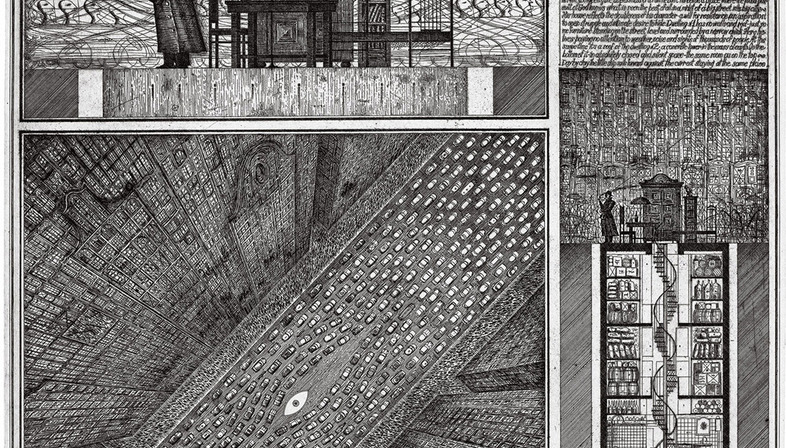
A couple of students who met during university, Alexander Brodsky and Ilya Utkin, will find a unique form of collaboration, coordinating the extraordinary talents they were both gifted with in a single extraordinary synergy. Working as a duo, they dedicated entire months to engrave elaborate copper plates from which those equally astonishing etchings are born that, from the flavor of their patina similar to certain prints of the past, disclose an exuberant, intelligent eclecticism that had nothing to do with the opaque, impersonal dominant utilitarianism. The etching technique, as Alexander will later reveal in an interview, allowed to engrave, a very important quality, which conveyed the wonderful sensation of a really deep space beyond the paper. It is with audacity that they portray spectacular urban landscapes, stages crowded with the most extravagant contaminations, references, almost maniacally reproduced, drawn from classical mythology or visionary intuitions linked to an almost science-fiction world, versatile and wise mosaics where primitive industrial structures coexist alongside ancient monuments or constructivist towers. Fantastic cities that sprout into chaotic metropolises or within excessively compact agglomerations, where “alone characters in precarious positions, attempting to reach unknown destinations… solitary figures trying to balance individuality and communal cause” highlight the failure of Soviet ideologies, demonstrating how cities had transformed into environments of isolation and alienation.

Ronald Feldman, owner of a famous gallery in New York, mesmerized and fascinated by their pieces, organized an exhibition in America, exceptionally successful, that brought them to the attention of the Western culture. As he writes, referring to their works, "architecture was presented as a theater, which created a context for the viewer to glimpse architecture as life…a pairing of Piranesi and Pirandello, combined with Russian history, theater, and literature”. In a world that seemed deprived of any vital creative breath, the two artists divulge a message that they hope will be grasped by others: " We are still thinking outside the box, breathing our creativity inside your dead concrete boxes ". And it is precisely these claustrophobic 'boxes', characterized by a sad, gray and anonymous repetitiveness, which often recur in their drawings, offering occasion to express that deep disappointment they feel for those boxes that hermetically contain so much sadness and do not reserve a kind of life that everyone deserves. Alexander and Ilya frequently accompany their works with inscriptions and writings, and in their etching ‘Dwelling House of Winnie-the-Pooh’, with reference to the book that had made especially Alexander dream during his childhood, the texts emphasize that people in a large modern city, like the one in their country, do not have three fundamental prerequisites for feeling happy. First of all, "a few windows lost in an ocean of the same windows on the huge facade of an apartment building " cannot allow us to think this is my home, then everyone " feels frustrated " because " they would love to decorate their houses distinctively, to make them different from all the others” and finally there is a lack of " especially dear places close to which everyone would like to live ". Man feels particularly isolated, without the comfort of reference points. He doesn’t have the sensation to belong to a real community, his privacy and individuality have been erased.
The book of A.A. Milne had always inspired the little Alexander, suggesting him a very different and very reassuring image of the city. The landscape that he fed in his mind was conform with the amusing map of the animals that lived happily in the forest on the trees. " In some way I saw life in a big city like life in the forest” he will recall,” …you know some roads and some places, you know the road to your friend, to the other friend there is a number, sometimes a very big number, of ways you use. And this reminds me of one little house, the other little house, and the forest”. An idealization that could not find any confirmation in the alienating urban planning of his hometown, Moscow, where one could only painfully find the total lack a familiar atmosphere and a pervasive, bleak anonymity. The techniques of the industrialized architecture, with their interlocking volumes all exactly the same, had cleaned up the Soviet streets of old buildings of the past, destroying entire historic districts and from this terrible discomfort the two architects-artists rise the enormous concrete mausoleums of the 'Colombaria' series, in which the old buildings threatened with destruction are preserved as urns of the ashes of the dead, "stacked on shelves like a kind of cabinet of curiosities ". However, it does not seem to be just an attempt to preserve external public facades but, representing in a sort of confused mixture public and private situations, the reference to the communal apartment appears quite clear, large apartments, once owned by the wealthy, and later densely overpopulated, shared by many families with their poor possessions.
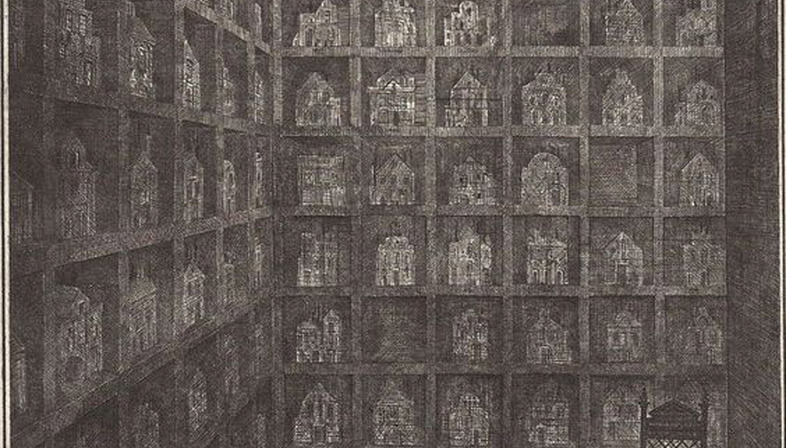
The confiscated and shared apartment, which according to the Bolshevik revolution, in the name of a full communism of goods, should have celebrated the abandonment of any selfish desire, had made everyone's life particularly unpleasant and difficult, completely abolishing privacy and extending forms of forced surveillance present almost everywhere, even in the private sphere. Brodsky and Utkin are particularly sorry that the house, nostalgically lived as a place of childhood, full of memories, had been destroyed by the terror provoked by Stalinism, not allowing even the preservation of photographs of anyone who had possibly been reported as dissident of the system. Whoever occupies a house must preserve its memories, just “like a conservator or even a curator”. The house becomes an allegory of memory, that memory that Milan Kundera, a few years earlier from exile, in his 'The Book of Laughter and Forgetting’, defined the most important act of resistance against the danger of control exercised by radical ideologies: "the struggle of man against power is the struggle of memory against forgetting ".
In 'Ship of Fools', we can instead read the compendium of another aspect of the autobiographical experience of the two authors that can be recognized self-portrayed about to embark on a voyage in the middle of the sea among the "jolly company of their friends”. The small and poorly equipped boat easily suggests from its size the risks that they will have to overcome amidst storms and dangerous currents. The metaphorical evocation of the threats to which they are exposing themselves is evident: " these passengers are not only dreamers: they are part of a real resistance. They are putting on brave faces, their futures are uncertain ". These "architectural fairy tales on paper", as they were defined, narrate through precious, exquisite monochromatic etchings this long, difficult and painful story, made up of very courageous choices, studded with great sacrifices and renunciations, but that, unlike many others which have not seen a happy ending, was crowned with the deserved success.
Virginia Cucchi
Credits:
Paper Architects :
Images of Alexander Brodsky & Ilya Utkin / Courtesy of Alexander Brodsky
Ronald Feldman Gallery : https://feldmangallery.com/










